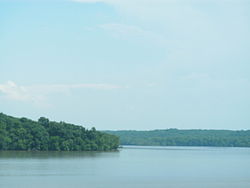Kittamaqundi
| Kittamaqundi | |
|---|---|
| Piscataway village | |

|
|
| Country | |
| State |
|
| County | |
| Government | |
| • Tayac | Kittamaquund |
| Population (2013) | |
| • Estimate () | Disbanded |
| Time zone | EST (UTC-5) |
| • Summer (DST) | EDT (UTC-4) |
Coordinates: 38°42′06″N 77°02′36″W / 38.701786°N 77.043445°W
Around 1622, the Piscataway tribe, which led the Conoy Federation, built a town they soon called Kittamaqundi on Piscataway Creek near the modern day town of Piscataway, Prince George's County, Maryland. When English first visited the town, in 1634, they learned it was named after the relatively new Tayac (Emperor) Kittamaquund, who had assumed power the previous year after killing his brother Wannas.
Some English translated the Algonkian name Kittamaquund as Chitomachen. One author translated Kittamaqundi as "Great Beaver Place" and Chitomachen as "strong bear".
Previously, the Piscataway's principal town (and the site of its cemetery and holy places) had been Moyaone on the Accokeek Creek near the Potomac River, which was abandoned after a fire. Famine and disease in previous years, and retaliation by either the English or tribes in the Powhatan Confederacy could have contributed to Moyaone's abandonment, for Kittamaquund would pursue an assimilation or accommodation strategy with the English. Wahunsenacawh, the former paramount chieftain of the Powhatan Confederacy across the Potomac River, had died in 1618, and in his last years had convinced his subordinate tribes near Jamestown, Virginia (including the Kecoughtan and Chickahominy) to stop trading grain to the English settlers, who he wished would leave. The Piscataway (later called the Piscataway-Conoys), who although speaking a related Algonquin tongue were not under Powhatan's control, remained willing to trade foodstuffs with the English who sailed to their village, since they sought assistance against Susquehannock and Seneca raiders. On March 22, 1622, the new war-leader of the Powhatan Confederacy, Opchanacanough, led a series of coordinated attacks on English settlements, nearly wiping out the Jamestown settlement but for warnings given the colonists by natives friendly to them, thus beginning the second Anglo-Powhatan war.
...
Wikipedia
